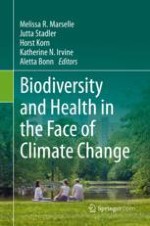-
Climatic change shapes the regional distribution and abundance of disease vectors.
-
There are important knowledge gaps with relation to VBDs and biodiversity.
-
A variety of new biological and genetic vector control tools are under development.
-
VBD control needs a trans-sectoral One Health approach, not just the health sector.
-
VBD control and elimination should be based on a wider understanding of planetary health.
4.1 Triple Vulnerability: Climate Change, Biodiversity and Vector-Borne Diseases
Mosquitoes | Ticks | Sandflies | Triatomine bugs | Tsetse flies | Fleas | Black flies | Aquatic snails | Lice | ||
|---|---|---|---|---|---|---|---|---|---|---|
Aedes
|
Anopheles
|
Culex
|
Ixodes, Dermacentor, Hyalomma
|
Phlebotomia
|
Triatominae
|
Glossina
|
Simuliidae
|
Biomphalaria, Bulinus
| ||
Chikungunya, Dengue fever, Lymphatic filariasis, Rift Valley fever, yellow fever, Zika | Malaria, Lymphatic filariasis | Japanese encephalitis, lymphatic filariasis, West Nile fever | Crimean-Congo haemorrhagic fever, Lyme disease, relapsing fever (borreliosis), Rickettsial diseases (spotted fever and Q fever), Tick-borne encephalitis, Tularaemia | Leishmaniasis, sandfly fever (phelebotomus fever) | Chagas disease (American trypanosomiasis) | Sleeping sickness (African trypanosomiasis) | Plague (transmitted by fleas from rats to humans), Rickettsiosis | Onchocerciasis (river blindness) | Schistosomiasis (bilharziasis) | Typhus and louse-borne relapsing fever |
4.2 Disease-Transmitting Mosquitoes and Ticks
4.2.1 Influence of Temperature on Vector Mosquitoes and Associated Pathogens
4.2.2 Distributional Changes of Mosquito Vector Species
4.2.3 Distributional Changes of Ticks in Europe
4.3 Biodiversity and VBDs: The Large Unknowns
4.3.1 Pathogen Diversity
4.3.2 Vector Diversity
4.3.3 Host Diversity
4.4 How to Manage VBDs?
4.4.1 Chemical Insecticides
4.4.2 Biological Insecticides
4.4.3 New Genetic Tools in Vector Control
4.4.4 Sustainable Control Programs
4.5 Responses to VBDs Along with Biodiversity Loss and Climate Change
4.5.1 Target the Complexity
4.5.2 Interconnecting People and Knowledge
4.5.3 Policy Options
SDG | Relationship to VBDs | Example |
|---|---|---|
Goal 3.
Ensure healthy lives and promote well-being for all at all ages
| VBDs are a major contributor to global morbidity and mortality | VBDs account for > 17% of the global burden of infectious diseases; > 80% of the global population is at risk from one VBD, with > 50% at risk of two or more VBDs. |
Goal 6.
Ensure access to water and sanitation for all
| Investment in clean water and sanitation can reduce the risk from VBDs | Open stored water containers are a major habitat for immature dengue, chikungunya and Zika virus vectors worldwide; provision of piped water and/or mosquito-proof water storage containers can reduce the transmission of these diseases. |
Goal 11.
Make cities inclusive, safe, resilient and sustainable
| Ending VBDs makes cities (and slums) safer | Resilience against VBDs needs to be included in strategic planning for urban development. |
Goal 13.
Take urgent action to combat climate change and its impacts
| Mitigating the impacts of climate change has the potential to reduce VBDs | VBDs are highly sensitive to climatic conditions, especially temperature, rainfall and relative humidity; patterns of epidemiology change more rapidly than health policy can respond; climate change can impact all VBDs. |
Goal 15.
Sustainably manage forests, combat desertification, halt and reverse land degradation, halt biodiversity loss
| Maintaining terrestrial ecosystems and halting biodiversity loss will help reduce VBDs in some places, but increase it in others | Bio-reserves can harbour vector populations in protected areas. Biodiversity loss (such as that associated with deforestation) may enhance the risk of some diseases such as malaria, while biodiversity gains (such as that associated with reforestation) could sometimes increase the risk for other diseases |
Significantly reduce the impact of invasive alien species on land and water ecosystems | Invasive vector species (e.g. Aedes albopictus) | |
Promote fair and equitable sharing of the benefits arising from the utilisation of genetic resources and promote appropriate access to such resources | Biological vector control |
